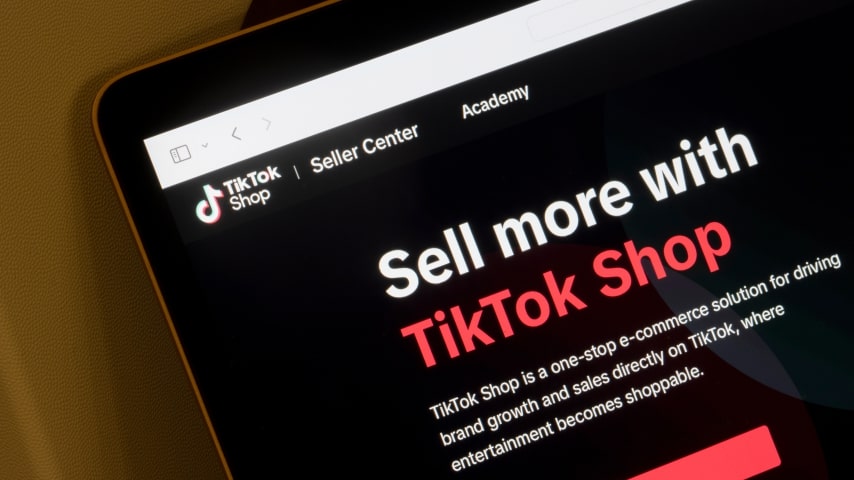Your business, your way – sell with Printify
There are plenty of options for selling on social media, and we’re here to help you seamlessly transform social media sites into profitable sales channels.
Explore how to sell on social media – generate leads, practice social selling strategies, and integrate social commerce features with your online store from a partnered eCommerce site.
Social selling vs social commerce
To make social media networks more effective for merchants, sales professionals distinguish two specific marketing strategies – social selling and social commerce. Here’s the difference:
- Social Selling Strategy – establishing a social media presence to network and build brand awareness, promote products, and develop target customer loyalty.
- Social Commerce Strategy – advertising or selling products to social media users with an integrated checkout system to diversify and shorten the sales cycle.
Tip
Check out our free TikTok Shop Integration to easily sync your store and start selling print-on-demand products seamlessly on TikTok with Printify.
Choose platforms to sell on social media
There is no one best social media platform to sell products on. Consider factors such as the potential for future customers, sales channel compatibility, influence on purchase decisions, eCommerce functionalities, and the necessary budget for a social media marketing strategy.
Here’s how to sell products on social media channels and the key features of each platform:

Facebook is the largest social media platform with the most active monthly users. It’s excellent for generating business leads, managing a community page for customers, and driving sales.
Begin by creating a Facebook Business account to unlock a range of selling features. Then, link your existing Facebook Business Page or set up a new one to create a dedicated place to host your eCommerce sales functions. Once done, you can integrate your store catalog.
Here are all the ways you can start selling on Facebook:
Facebook shops
This is an excellent option for beginners or small business owners. Facebook Shops lets you build an audience and curate your brand identity while selling directly from your business page. The integrated feature allows customers to purchase without leaving the app.
Make sure your region has Facebook Shops enabled. View official Facebook Shop Location updates to follow up on commerce availability.
To create a Facebook Shop on your business page, click the Create your shop page section to get started. Follow the steps to sync your eCommerce hosting platform, choose the direct Facebook checkout method, and select your catalog to easily tag store products on your feed.
Facebook marketplace
Initially designed as a consumer-to-consumer sales platform, Facebook Marketplace has since enabled integrations with eCommerce platforms, allowing on-site listings and checkout options. This is a good place to test your listing quality and analyze competitors.
The easiest way to list your products on Facebook is to navigate to Marketplace on your Facebook app, click Sell Something, and follow the steps to list your item. Add details, set a price, and publish. Tap into local selling or expand your reach by shipping items.
Facebook live shopping
Facebook Live Shopping allows businesses to showcase and sell their products in real-time through live video broadcasts. It’s a great way to engage with your community and establish a brand style through video content, presenting all the product features for added social proof.
Initiate a Facebook Live session showcasing new releases and details. Add featured products, engage with viewers, and enable shopping tags for direct purchases during the live session.
Facebook catalogs
This is one of the best ways to shorten the number of clicks a customer needs to access your inventory. Create and edit catalogs by adding listings manually or sync products through a Meta-partnered eCommerce platform that integrates directly from your site.
Once you’ve created a catalog, it becomes easier to list, edit, and sell products all in one place. Tag items in your marketing content or display product listings through paid Facebook ads.
Facebook ads
Facebook ads are paid content displayed on the Facebook feed or sales pages for targeted audiences. Different ad types include image ads, video ads, slideshow ads, and other dynamic options for collecting user information to generate leads and build brand awareness.
Utilize the Facebook Ads Manager to create targeted ad campaigns. Define your audience, set a budget, and design compelling visuals. Take advantage of the different ad formats, including Facebook Carousels, for multiple product images or video showcases in a single post.
Facebook messenger
For more personalized eCommerce sessions, enable shopping in Messenger by integrating your product catalog. The chat app allows merchants to respond to customer inquiries promptly and use Messenger for order confirmations, updates, and personalized shopping assistance.
TikTok

TikTok has a vibrant user base with the fastest-growing social ad revenue from any platform. The social media app provides excellent creative tools to create a narrative for your brand and showcase products by capturing trends for the younger and more content-driven demographic.
Begin by setting up a Pro Account and enter the TikTok Ads Manager to access its commerce tools. Connect and verify your eCommerce website to link products in its integrated product catalog. Start now with our TikTok Shop integration to link products with Printify seamlessly.
Explore TikTok as a sales platform and implement digital marketing using the following social selling and commerce features:
TikTok shop
TikTok Shop helps brands utilize short-form videos to foster community trust, increase product discovery, and enable purchases. The platform’s product tags feature allows users to browse curated collections, discover trending products, and buy items without leaving the app.
Not only can you curate your own branded content, but you can also collaborate with other TikTok influencers. Use the TikTok Affiliate program to feature products tagged through partnered creator accounts via commission. This is an excellent way to reach existing niche audiences.
Shoppable TikTok ads
Enable paid product discovery with Shoppable TikTok Ads. The platform’s advertising blends organically with user-generated videos, marked with a Shop Now button. Use the TikTok Ads Manager to enable shoppable features for your content, select ad objectives, and set a budget.
TikTok live shopping
To advertise products in real-time, try the TikTok Live Shopping feature. Like other social media platforms, it’s a way to connect with customers directly and boost product performance through interactive user engagement. Select your products and get started.
Initiate a live session by creating a new post and selecting the Go Live button. Then, toggle on the Shopping option, allowing you to link and showcase products instantly from your catalog on screen. All that’s left is encouraging viewers to purchase directly from the links.

Instagram is the second-largest social network with an extensive user base, boasting 1.35 billion members globally in 2023. Integrated with Facebook as a Meta product, you’ll have similar features for making money on Instagram through a shared platform Meta account.
Sell products on Instagram with the following commerce and social selling tools:
Instagram shops
Integrate your online store by linking a Facebook Shop to your Instagram business profile, allowing followers to browse and purchase products directly from your account. Boost product visibility by tagging items in both posts and stories, providing convenient in-feed purchase links.
Instagram live shopping
Engage your audience in real-time by hosting Instagram lives featuring product demonstrations or launches. Viewers can make purchases right after the live video while the impression is still fresh in their minds. In this way, you can foster a direct and interactive shopping environment.
Instagram stories with product stickers
Set up interactive promotions with product stickers in Instagram Stories. Users can tap on these stickers to explore more details about featured products. This can be a great daily product advertising strategy, helping maintain marketing efforts and boost brand awareness.
Instagram sds and carousels
Elevate brand visibility on Instagram even more through paid advertising from the Facebook Ads Manager. Get started with Instagram Ads, from promoted photos, reels, and collections to Instagram Carousels that can help create a content narrative with a list of swipeable media.

With almost half a billion active monthly users, Pinterest is the go-to place to curate products and sell your brand aesthetic. Connect your eCommerce store through a free Pinterest business account to set up all the tools you’ll need to start selling products on Pinterest.
Pinterest boards and product pins
Pinterest’s content feed works with pins – bookmarks people use to save images, videos, or products they like. To use this feature, connect your eCommerce catalog and create rich product pins to enable real-time updates on pricing, availability, and direct page links.
Once you have a range of pins, use the Pinterest Boards feature to curate themed collections of products and related media. Ultimately, the goal is to organize visually appealing boards with interactive products to enhance user engagement and streamline the path to purchase.
Add products to the selected social media platforms
Ensure your store catalog is optimized and regularly updated before syncing or adding products separately to social media sales channels. Organize the catalog neatly by creating product groups or collections into relevant categories. This makes content easier to find.
Include essential information on your listings, writing compelling product descriptions and clear pricing, shipping, and availability specifications. Put special attention on featuring high-quality product photos to enhance the overall aesthetic so it’s well-optimized for highly visual platforms.
Make it happen today!
Decide how to price products

Pricing products effectively for your needs and social media market dynamics is a huge determiner for success. Take time to explore how to price products for ultimate success.
The main factors to consider when setting up your price are estimated fixed business costs and variable expenses for producing each product, what your audience is willing to pay, the product costs of your competitors, and, of course, a reasonable profit margin that makes it all worth it.
Implementing one of the following five pricing strategies can further optimize your approach:
- Value-based pricing:
Focus on the perceived value to the potential customer and target audience, considering their willingness to pay for unique features or benefits via online shopping.
- Cost-plus pricing:
Add a markup percentage to the production cost to cover all expenses so that you can reliably generate profit from your sales quotas.
- Competitor-based pricing:
Set prices in line with competitors and industry trends, positioning your products based on similar offerings in the market.
- Dynamic pricing:
Adjust prices based on real-time market demand, allowing flexibility in response to changing conditions and new target audience expectations.
- Psychological pricing:
Utilize pricing techniques that appeal to consumer psychology, such as setting prices just below round numbers to create a perception of affordability.
Promote your products
Select the appropriate marketing objectives and ad types for your store depending on your level of expertise and product offers.
Facebook, Instagram, and TikTok provide a variety of ad formats, including image and video ads, carousels, story ads, live shopping ads, and more. Determine which ads best resonate with your audience and social media, and calculate the associated costs you’re willing to pay.
For more information on specific social media advertising, check our detailed guides:
After selecting a content base, define clear marketing objectives to guide your campaigns effectively. Common objectives include brand awareness, lead generation, website traffic, and conversions. Tailor your content to match your desired results, ensuring consistent metrics.
Why it’s worth selling on social media

Harnessing platforms like Facebook, Instagram, and TikTok not only enhances your store metrics but also provides numerous specific advantages for building relationships and marketing:
Cost-effective marketing
Social media helps businesses reach a vast existing audience with minimal investment. Finding an appropriate social media platform that already caters to your target market, coupled with targeted ads, ensures your products find your niche, optimizing your marketing and ad spend.
Builds social proof and trust
Social media is a powerful tool to build social proof and establish trust with your audience. Positive reviews, relevant hashtags, and success stories from previous customers shared on these platforms create a sense of authenticity, encouraging potential customers and enhancing your brand’s credibility.
Direct customer interaction
Social media platforms allow you to foster a sense of brand community by responding to questions, addressing concerns, and starting meaningful conversations. This direct interaction strengthens customer relationships and provides valuable insights for refining your products for future success.
Boost web traffic
Social media serves as a gateway to your online store, driving significant web traffic. When well-optimized, strategic use of call-to-action buttons and clickable product tags on posts can lead target customers to your eCommerce site, translating engagement directly into sales.
Acquire more analytics
Social media platforms offer robust analytics tools (like Facebook Insights, Instagram Insights, and Pinterest Analytics) that provide insights into customer behavior, preferences, and demographics. Leverage these analytics to refine your marketing strategy, tailor product offerings, and optimize the overall customer experience for increased conversions and further growth.
Sell on social media with Printify

Start selling on social media right away. Connect our print-on-demand network to your business and access an automated eCommerce platform with seamless product integration.
Printify empowers merchants to create custom products with easy-to-use print design software, adding value for customers and driving more sales with less effort. Start for free and earn while we handle fulfillment and delivery, and your customers take care of the production costs.
Go from zero products to a full catalog ready for social media selling in just a few simple steps:
- Create an Account. Register for free and check out the Printify business model.
- Pick a Product. Choose merchandise from hundreds of items in the Printify Catalog.
- Apply Your Design. Add custom print designs using the Printify Product Creator (previously known as Mockup Generator).
- Connect a Store. Add an eCommerce integration to your storefront and social media.
- Start Selling on Social Media. Promote and sell your custom-made Printify products on social media with minimal investment and a full inventory of available products.
To summarize
Social platforms play a crucial role as sales channels when setting up your digital store or marketplace listings. Choose from various social media accounts for businesses to generate new leads for potential customers, providing an integrated product catalog and in-app shopping.
Navigate the nuances of social media platforms like Facebook, TikTok, Instagram, and Pinterest to set up a social media store, build relationships with customers, explore advertising types and systems, and curate a professional brand!












